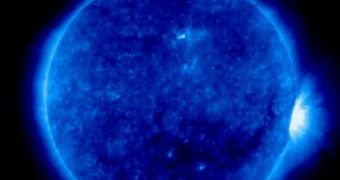The scientific community has been rather excited this week, as the SOHO spacecraft has captured in images what seems to be a small magnetic knot appearing on the surface of the Sun, announcing the end of the 23rd Solar Cycle, which has peaked during 2000 and 2003 with violent solar storms and material ejection.
Originally discovered in the year 1843 by Samuel Heinrich Schwabe, after studying the solar activity and the solar spots on its surface for more than 17 years, the solar cycle has an average duration of about eleven years. However, this duration is not stable, as there have been periods of time when the solar cycle lasted 9 years, or even 14 years.
Although triggered by violent magnetic activity which also comes in cycle, with duration periods of 22 years, it seems that surface solar activity observed in the sun, most of the solar cycle activity, does not present strong interaction with it, thus the solar cycle duration remained to be 11 years. However, about half of century after the magnetic cycle period has been determined, scientists showed that, in fact, not only the sunspots were magnetized, but the whole surface of the Sun and the solar cycle were determined by action of the magnetic field as a whole.
Changes in the structure of the solar magnetic field generate polarity reversal in the solar sun spots, which can result in massive mass ejections in the upper layers of the Sun's atmosphere, which get carried out in the outer regions of the solar system by the solar wind. Such solar storms hitting Earth can knock out an artificial satellite, and even the electric power line on the surface of the planet.
Even though this magnetic knot on the surface of the Sun is considered a sign that the solar cycle had ended, nothing is really concrete, not even the moment when the next solar cycle will begin. According to David Hathaway, from the Marshall Space Flight Center, the solar cycle always begins when the magnetic lines of the sun spots, on the surface of the Sun, reverse their polarity relative to that observed during the last solar cycle, and occur in the high-latitude area of the Sun, around the 25 or 30 degrees latitude.
It seems that both conditions that describe the beginning of a new solar cycle are met by the small magnetic knot, which appeared on December 11th, but the problem is that there are no visible sunspots, which usually form as matter of the surface of the Sun gets cooler than the surrounding material.
Predictions regarding the 24th Solar Cycle, that will peak in the years 2011 or 2012, reveal that it will probably be one of the most violent peaks in the last years, and could greatly affect the electrical components place in orbit and on the surface of the Earth.
If scientists are right and, indeed, a new solar cycle has began, the activity would slowly increase in the next years.

 14 DAY TRIAL //
14 DAY TRIAL //